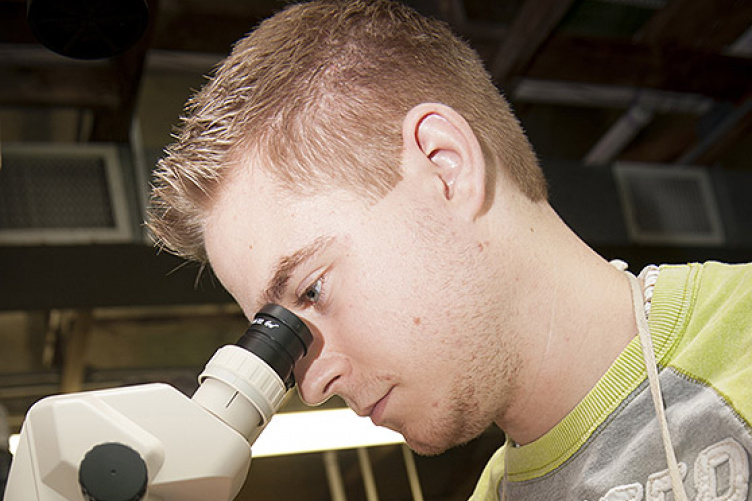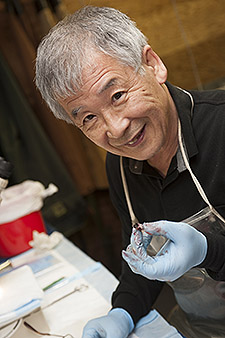
Pre-medical student Tim Marquis
As an undergraduate research assistant in the Center for Molecular Endocrinology at the University of New Hampshire, student Tim Marquis is gaining hands-on experience with world-class research opportunities. Last Memorial Day weekend – while other college students were barbequing on the beach – Marquis was in the hatchery at UNH learning how to conduct immunohistochemistry procedures to determine the localization and distribution of lamprey hormones with internationally renowned Japanese comparative neuro-endocrinologist, Masumi Nozaki.
“Professor Nozaki is known as the world expert in immunohistochemistry of protein hormones and receptors in the brains and pituitaries of non mammalian vertebrates, particularly fish,” says Stacia Sower, Director of the Center for Molecular Endocrinology at UNH. Sower and Nozaki worked together as post-doctoral researchers at the University of Washington in Aubrey Gorbman’s laboratory. “Gorbman was one of the founding fathers of the field of comparative endocrinology,” says Sower about this rare American scientist to receive Japan’s top Medal of Science. Over the years Sower and Nozaki continued to conduct research together from afar, and Nozaki, who developed techniques in immunohistochemistry while he was a graduate student and later refined his procedures during his tenure at the Niigata University’s Sado Marine Station, became a visiting professor at UNH in 1993, practicing and sharing his knowledge of immunohistochemistry.
|
Renowned Japanese Researcher Masumi Nozaki |
“Masumi is a master artist,” Sower says of Nozaki’s intricate slides that resemble stained glass windows with the reds, blues, and greens of co-localized hormones clearly delineated within the same cell. “He does beautiful work – you can actually see the cell itself. He does double staining.” Beauty is only ancillary to the important work that Sower, Nozaki, and others are doing to help show that the pituitary historically arose with vertebrates, not with invertebrates. And while the lamprey has a notochord (precursor to a backbone), its brain is encased in a cartilaginous cranium, making the species closer to its ancestral vertebrates that existed 550 million years ago. “The acquisition of the pituitary was a seminal event for vertebrate evolution,” says Sower about the tiny gland that sits at the base of the brain. Now it is rightfully seen along with the part of the brain called the hypothalamus, the center of control over the endocrine system.
When Sower began her work with these ancient, jawless fish known as cyclostomes more than thirty years ago, people didn’t even think that the lamprey had the same brain control as other vertebrates. The focus of her research has evolved over time as well, and she’s currently studying the extent of hypothalamic control over the pituitary-gonadal aspect in cyclostomes.
Nozaki’s most recent visit corresponds with the spawning of lamprey. “We do twelve months of experiments in six weeks,” says Sower about the primitive fish that spawn and die all within a narrow window of time. Accompanying Nozaki is Maki Nishiyama, a Ph.D. student learning the research techniques he developed. Sower’s team at the Center for Molecular Endocrinology have already identified structures in the lamprey brain and pituitary gland, cloned hormones, and sequenced the fish’s genome as well as discovered the gonadotropin-releasing hormone, a peptide released from the brain that stimulates the pituitary to secrete the hormones that control the sex glands. Nozaki and Nishiyama spent their time here working with the team to study the next steps of function and distribution of immunohistochemistry in the lamprey.
Within all of this highly skilled research there still exists space for teaching and learning. Marquis has taken the initiative to further the studies using the process of in-situ hybridization to look for the expression of mRNA transcript found in the pituitary or one of its subunits. In fact, Marquis has just proven the existence of a pituitary hormone subunit, “beta 5,” which enables Sower’s team to proceed with a major grant proposal.
“It is an absolute honor to study under Dr. Sower and to have learned so much in the time that I’ve been here,” says Marquis who began assisting with research in Sower’s lab during his freshman year. “Dr. Sower has been an incredible mentor and role model. I wouldn’t be here today without her help, support, and encouragement,” he says. As a biomedical science major in the medical veterinary science option, Marquis plans to attend medical school after graduation to facilitate his career goals of becoming an oncologist and conducting biomedical research. As for a chance to learn from Nozaki, Marquis says, “We are especially lucky to have Dr. Nozaki with us this week. Learning his immunohistochemistry techniques will have a direct impact on my research in this lab.” The Sower lab at the Center for Molecular Endocrinology spans disciplines of neuroscience, neuroendocrinology, molecular, biomedical, and biochemical sciences.
After decades of friendship and collaboration, many discoveries – such as the fact that fish have both luteinizing hormone and follicle stimulating hormone – have been landmarks for both Sower and Nozaki. In the interest of working together once more before Nozaki’s retirement next March, Sower invited Nozaki and Nishiyama to UNH last May. “One lab can’t do all the work that’s necessary,” says Sower. “You have to be collaborative to be successful.”
Originally published by:
-
Written By:
Staff writer | Communications and Public Affairs




















































